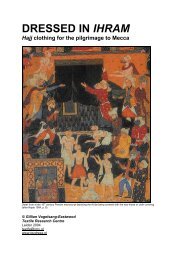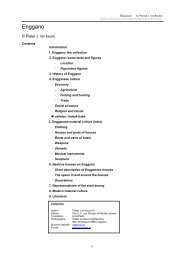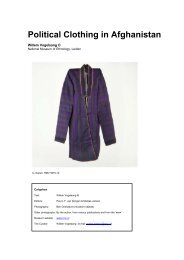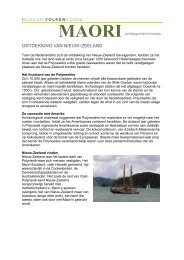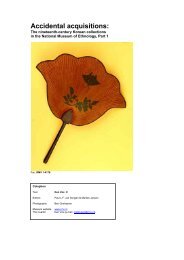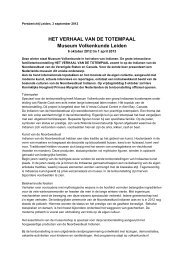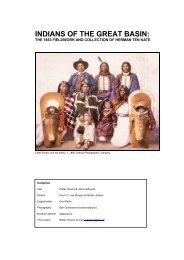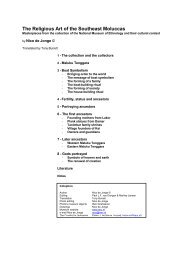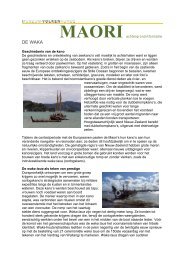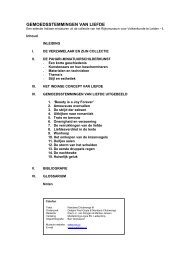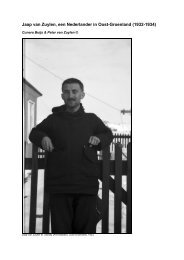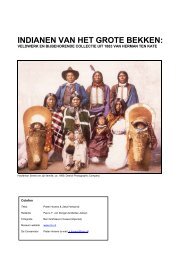QAJAR DRESS FROM IRAN - Museum Volkenkunde
QAJAR DRESS FROM IRAN - Museum Volkenkunde
QAJAR DRESS FROM IRAN - Museum Volkenkunde
You also want an ePaper? Increase the reach of your titles
YUMPU automatically turns print PDFs into web optimized ePapers that Google loves.
<strong>QAJAR</strong> <strong>DRESS</strong> <strong>FROM</strong> <strong>IRAN</strong><br />
in the National <strong>Museum</strong> of Ethnology, Leiden<br />
Gillian Vogelsang-Eastwood © September 2001<br />
Colophon<br />
Author Gillian Vogelsang-Eastwood ©<br />
Curator Southwest & Central Asia Dr. Willem Vogelsang<br />
Editing Paul van Dongen & Marlies Jansen<br />
Photos museum objects Ben Grishaaver<br />
Black and white photos A. Sevruguin, collection RMV<br />
<strong>Museum</strong> website www.rmv.nl<br />
E-mail willemv.rmv.nl
Introduction<br />
<strong>QAJAR</strong> <strong>DRESS</strong> <strong>FROM</strong> <strong>IRAN</strong> IN THE NATIONAL MUSEUM OF ETHNOLOGY © GILLIAN VOGELSANG-EASTWOOD<br />
Digital publications of the National <strong>Museum</strong> of Ethnology<br />
The Hotz collection of Qajar era dress is unique in Europe, America, and indeed Iran. There are no<br />
other large collections of dress that can be so accurately dated (1883). Another factor that makes this<br />
collection so important is that Hotz bought complete outfits, rather than individual items of clothing.<br />
This means that we can now develop a good understanding of the construction and appearance of<br />
dress, especially for men, from a period that saw great social and economic changes in Iran.<br />
An important provincial official surrounded by his entourage. The seated official is wearing a western style shirt with collar under<br />
his elaborate overcoat (photograph by A. Sevruguin, RMV no. 3219).<br />
Photo front page:<br />
A group of ladies, maybe a woman of the harem with her daughters and servants. The ladies are wearing charqat (headcovers)<br />
over kolija (short jackets) and saliteh (short skirts), with white stockings. The servant is wearing a similar outfit plus an indoor<br />
chador. (photograph by A. Sevruguin; RMV no. 3249)<br />
2
Table of Contents<br />
Introduction<br />
<strong>QAJAR</strong> <strong>DRESS</strong> <strong>FROM</strong> <strong>IRAN</strong> IN THE NATIONAL MUSEUM OF ETHNOLOGY © GILLIAN VOGELSANG-EASTWOOD<br />
Digital publications of the National <strong>Museum</strong> of Ethnology<br />
1 The Hotz Collection<br />
The Qajars<br />
Albert Hotz (1855-1930)<br />
2 The International, Colonial and General Exportation Exhibition, Amsterdam, 1883<br />
Hotz, the Exhibition, and the RMV<br />
3 Male Dress<br />
Later nineteenth century men's dress<br />
Arabian clothing<br />
4 Female Dress<br />
Indoor urban clothing<br />
Outdoor urban clothing<br />
Provincial clothing for women<br />
5 Footwear<br />
Socks (jurab)<br />
Shoes, sandals and giveh<br />
6 Bibliography<br />
Notes<br />
3
1. The Hotz Collection<br />
<strong>QAJAR</strong> <strong>DRESS</strong> <strong>FROM</strong> <strong>IRAN</strong> IN THE NATIONAL MUSEUM OF ETHNOLOGY © GILLIAN VOGELSANG-EASTWOOD<br />
Digital publications of the National <strong>Museum</strong> of Ethnology<br />
More than one hundred years ago, in 1883, the National <strong>Museum</strong> of Ethnology (RMV), Leiden, the<br />
Netherlands, purchased a large collection of miscellaneous Iranian objects from a Dutch merchant, Albert<br />
Hotz. The collection consists of over 400 items, including armour, horseshoes, candle sticks, mirrors,<br />
models of ships, and even parts of doors. There are also many items of clothing and footwear. These<br />
articles of dress make up the subject of the present publication.<br />
It should be noted, however, that this publication is not an exhaustive catalogue. It rather provides a brief<br />
introduction to the Qajar dynasty and nineteenth century Iran, to Albert Hotz, and to some of the main<br />
types of costume and footwear contained in the collection.<br />
The Qajars 1<br />
The objects collected by Hotz date from the late nineteenth century. At that time Iran was still ruled by the<br />
Qajar dynasty. The Qajars had dominated Iranian politics since the late eighteenth century. They came to<br />
power after many years of political anarchy. They originated from among the Turkish speaking, Turkmen<br />
tribes in Central Asia who in the Middle Ages moved west across North Iran towards what subsequently<br />
came to be called Turkey. In the centuries to follow, segments of the Qajar tribe were, either voluntarily or<br />
not, dispersed over a large part of the Iranian Plateau. One of these groups settled southeast of the<br />
Caspian Sea, in and near the modern district of Gurgan. In the eighteenth century the descendants of<br />
these settlers eventually managed to impose their rule upon the rest of Iran. In 1786, the Qajar chief,<br />
Agha Muhammad Khan, made the small town of Tehran into his capital, thereby shifting the traditional<br />
political centre of the country from further south (the cities of Isfahan and Shiraz) towards the north, close<br />
to the tribal lands of the Qajars (see map).<br />
Iran in the nineteenth century<br />
The Qajar period of Iranian history was one of relative political stability, but at the same time it saw some<br />
dramatic, and at times decisive developments that are still felt today. The rise of the Qajar state coincided<br />
with the emergence of an almost independent Shi'ite clerical class. The later Qajar period witnessed evergrowing<br />
external pressure from the side of the European powers, in particular Britain and Russia. In the<br />
late nineteenth century there was growing dissatisfaction among the court and some merchants with the<br />
4
<strong>QAJAR</strong> <strong>DRESS</strong> <strong>FROM</strong> <strong>IRAN</strong> IN THE NATIONAL MUSEUM OF ETHNOLOGY © GILLIAN VOGELSANG-EASTWOOD<br />
Digital publications of the National <strong>Museum</strong> of Ethnology<br />
autocratic rule of the Qajar kings and with Iran's backwardness as regards the European world. The<br />
resulting chaos led to the virtual division of the country between Britain and Russia, and the fall of the<br />
Qajar dynasty in 1924. The Qajars were succeeded by the Pahlavi dynasty that in its turn was abolished<br />
in 1979 during the Islamic Revolution.<br />
Iran's culture was deeply rooted in centuries of Persian statesmanship, which was guided by the conduct<br />
of the ruler, the etiquette of his court, and the organisation of the government. At the same time, and<br />
particularly during the nineteenth century, both court and country were being influenced by the outside<br />
world. The transitional nature of the Qajar era is evident in its attitudes towards modernity. Like its<br />
neighbour, the Ottoman Empire, Qajar Iran had to adjust its political and economic institutions to Western<br />
models, and very soon Iran's society was affected by Western concepts of education, dress, health,<br />
philosophy, trade and urbanisation, as well as methods of communication. As one can imagine, conflicts<br />
arose on many fronts.<br />
It was the interest expressed in Iran by European diplomats and merchants, including Albert Hotz, that<br />
was to have such a significant influence upon the future of the country. From the 1830s, more and more<br />
European and Russian goods were exported to Iran under the banner of free trade. While some Iranians<br />
benefitted from the import of cheaper manufactured goods, there was also a devastating effect upon<br />
Iranian domestic manufacturers and merchants, including the producers of textiles. It is clear that<br />
Europeans in Iran were generally regarded with some suspicion.<br />
Albert Hotz (1855-1930) 2<br />
Albertus Paulus Hermanus Hotz was born in Rotterdam on the 22nd January 1855. He was the son of<br />
Jacques Cornelis Paulus Hotz and Gertrude Arnolda Johanna Pino Post. In September 1874, Jacques<br />
Hotz set up a firm with the aim of establishing trade links between the Netherlands and Iran. This new<br />
company was called Vennootschap Perzische Handelsvereeniging J.C.P. Hotz & Zoon ("The Persian<br />
Trading Association J.C.P. Hotz and Son"). His son, Albert Hotz, went to Iran in late November 1874 (he<br />
was nineteen years old!) in order to further expand the new firm and to establish trading contacts between<br />
the two countries. However, he was forced to return in May 1875 when his father died suddenly. Albert<br />
Hotz reorganised his father's affairs and established a new firm within the Perzische Handelsvereeniging.<br />
The new company was simply called Hotz & Co.<br />
Albert Hotz in 1884<br />
In 1877 Hotz subsequently returned to Iran and set up trading offices in the city of Isfahan, and in nearby<br />
Baghdad and Basrah in the Ottoman Empire, in modern Iraq (see map). He also tried to persuade Dutch<br />
financiers and others to invest in Iran. However, in 1878, following a series of financial disappointments,<br />
all of Hotz's backers withdrew and Hotz returned to the Netherlands.<br />
In 1880 Hotz returned to Iran for the third time. He stayed there for some years, and went back in 1883 in<br />
order to help organise the Persian display of the International exhibition to be held in Amsterdam during<br />
5
<strong>QAJAR</strong> <strong>DRESS</strong> <strong>FROM</strong> <strong>IRAN</strong> IN THE NATIONAL MUSEUM OF ETHNOLOGY © GILLIAN VOGELSANG-EASTWOOD<br />
Digital publications of the National <strong>Museum</strong> of Ethnology<br />
the same year (see next chapter). Back in Europe, Hotz moved his European headquarters from the<br />
Netherlands to London. Shortly afterwards he returned to Iran and during the next few years he continued<br />
to run trading agencies in Bushire, Shiraz, Isfahan, Burujird, Sultanabad, Yazd, as well as Baghdad and<br />
Basrah in Iraq (see map). 3<br />
During this period Hotz's wide entrepreneurial interests became even more diverse. He was involved in a<br />
number of activities including coal mining, the setting up of the Imperial Bank of Persia, carpet industry,<br />
and the planned development of the Karun river (see map). 4 In March 1884 the governor of Isfahan, being<br />
the eldest son of the Shah of Iran, granted Hotz concessions to explore for oil in Khuzistan Province. 5<br />
Unfortunately for Hotz the rig failed to find any oil.<br />
In 1885 Hotz became the Dutch consul for Iran, based at Bushire on the Persian Gulf (see map). This<br />
trading city was of great importance to the Dutch, as much of the activity between the Dutch East Indies<br />
and the Netherlands passed through the Persian Gulf. 6 It was during this period that he had the<br />
opportunity to form a collection of textiles and other objects. Some of these items were lent to the<br />
<strong>Museum</strong> voor Land- en <strong>Volkenkunde</strong>, Rotterdam and were officially purchased by the museum in the<br />
1890s. 7<br />
From 1895 there was a general slump in international trade, and a number of European trading firms went<br />
under, including that of Hotz. The slump was to cause the Hotz family to suffer considerable financial<br />
difficulties and by 1903 Hotz and Son had ceased to trade.<br />
In 1906 Hotz became part of the Commissie van Advies voor 's Rijks Geschiedkundige Publicatiën<br />
('Commission for Advice for State Historical Publications') in The Hague. He was given the task of writing<br />
about the role of the Verenigde Oostindische Compagnie (VOC, the Dutch equivalent of the East India<br />
Company) in Persia. Then between 1909-1916 Hotz worked at the Dutch consulate in Beirut, becoming<br />
the consul in 1917. Hotz retired from this post on the 21st April 1921.<br />
When he came back to the Netherlands, Hotz tried to take up his research into the VOC again, however,<br />
ill health forced him to stop. In 1921 he retired to Lugano in Switzerland in order to be near his son,<br />
Hendrik, who was ill in a sanatorium in Davos-Platz. Sadly his son died in the same year.<br />
A.H.A. Hotz died on the 11th April 1930 at Cologny, near Geneva in Switzerland. He was buried in the<br />
cemetery Crooswijk, in his home city of Rotterdam.<br />
6
<strong>QAJAR</strong> <strong>DRESS</strong> <strong>FROM</strong> <strong>IRAN</strong> IN THE NATIONAL MUSEUM OF ETHNOLOGY © GILLIAN VOGELSANG-EASTWOOD<br />
Digital publications of the National <strong>Museum</strong> of Ethnology<br />
2. The International, Colonial and General Exportation Exhibition, Amsterdam, 1883<br />
Following the success of the Great Exhibition in London in 1851, a series of International Exhibitions were<br />
organised in Europe and North America. These exhibitions became important events that introduced new<br />
cultures, ideas and material items to curious visitors. One of the first exhibitions to include items from Iran<br />
was the Vienna Exhibition of 1873.<br />
The Iranian government was well aware of the value of such exhibitions and decided to have a pavillion in<br />
the planned exhibition at Amsterdam in 1883 (Internationale Koloniale en Uitvoerhandel Tentoonstelling).<br />
Hotz was commissioned by the Iranian Government to help with its organisation. The objects acquired in<br />
Iran by Hotz included carpets, musical instruments, ibex horns, lamps, trays and waterpipes, as well as<br />
textiles and items of clothing.<br />
Hotz, the Exhibition, and the RMV<br />
One of the organisers of the Amsterdam Exhibition was the director of the National <strong>Museum</strong> of Ethnology<br />
in Leiden (RMV), Dr. L. Serrurier. 8 He helped to organise various foreign pavillions, including that of Iran.<br />
By that time, Hotz was already known to the <strong>Museum</strong> for his travels and work in Iran. In September 1882,<br />
for example, Hotz acquired for the <strong>Museum</strong> a small collection of Persian items, including armour,<br />
weapons, pipes and trays. 9 Not surprisingly, Hotz was soon in negotiation with the <strong>Museum</strong> for the sale of<br />
the items that Hotz had acquired in Iran for the Iranian pavillion. He offered to sell the <strong>Museum</strong> various<br />
objects at cost price. It was finally agreed that the <strong>Museum</strong> would purchase a selection of items for<br />
1170.30 Dutch guilders, a considerable sum in those days. In November 1883, 357 items of Persian origin<br />
were consequently added to the <strong>Museum</strong> collection under accession number 503 (e.g. 503-282 is a pair<br />
of trousers; 503-267 is a man's jacket). It is this collection that includes the various items of dress that will<br />
be discussed in this publication.<br />
The Persian section at the International, Colonial and General Exportation Exhibition,<br />
Amsterdam 1883 (photograph by Alexandre & Co.)<br />
7
3. Male Dress<br />
<strong>QAJAR</strong> <strong>DRESS</strong> <strong>FROM</strong> <strong>IRAN</strong> IN THE NATIONAL MUSEUM OF ETHNOLOGY © GILLIAN VOGELSANG-EASTWOOD<br />
Digital publications of the National <strong>Museum</strong> of Ethnology<br />
There are very few collections of Qajar era dress outside of Iran. 10 The Hotz collection is especially<br />
noteworthy since it contains a large number of items for men. More particularly, it includes outfits for men<br />
from various groups, namely, scribes, mullahs, dervishes, merchants and farmers.<br />
Later nineteenth century men's dress<br />
By 1883 male dress in Iran had certainly started to change. This was mainly due to growing Western<br />
influence. The Qajar king, Nasr ud-Din Shah (r. 1848-1896), preferred more Western-style garments. His<br />
example was followed by his courtiers and subsequently copied by lower levels of Iranian society. Large<br />
segments of Iranian society, however, were slow in adopting Western-style dress; these included<br />
merchants, farmers and peasants. The garments collected by Hotz reflect this development, and include<br />
many traditional as well as more Western-style garments. The garments from the collection can be<br />
grouped as follows:<br />
Trousers (zir-e jumah and shalvar) 11<br />
Men's trousers came in two forms. The first, and more traditional type was loosely cut and normally made<br />
of white (e.g. 503-279) or blue cotton (e.g. 503-281). These were called zir-e jumah or very occasionally,<br />
shalvar. Another type were European military-style trousers, generally called shalvar, which tended to be<br />
worn by urban men of higher positions and members of the court. These trousers were made in white,<br />
blue or red cloth, and usually had a line of braid down the outside seams of the trouser legs.<br />
The baggier trousers of traditional style were more suitable for sitting on the floor, while the tight European<br />
trousers were designed for sitting on chairs. 12 The possession of such items of furniture, plus the<br />
necessary trousers, were consequently regarded as another indication of a person's wealth, status and<br />
‘modernity'.<br />
RMV 503-279 RMV 503-281<br />
8
Shirts (pirahan)<br />
<strong>QAJAR</strong> <strong>DRESS</strong> <strong>FROM</strong> <strong>IRAN</strong> IN THE NATIONAL MUSEUM OF ETHNOLOGY © GILLIAN VOGELSANG-EASTWOOD<br />
Digital publications of the National <strong>Museum</strong> of Ethnology<br />
These were unstarched shirts, with an opening either on the shoulder or down the front of the garment.<br />
Upper and middle ranking men tended to wear shirts made of white cotton (e.g. 503-247; 503-249), while<br />
the ‘lower orders' wore pirahans made of blue cotton.<br />
RMV 503-279<br />
Waistcoat (jeliqa)<br />
Although waistcoats are now widely used in Iran, they did not form part of the traditional dress for men.<br />
Europeans introduced this garment during the eighteenth century. Initially waistcoats tended to be worn<br />
by men living in the larger urban regions, such as Tehran, Isfahan or Bushire. The waistcoat (503-252) in<br />
the Hotz collection, however, is cut according to traditional Iranian dress concepts. It is a wide garment<br />
based on rectangles rather than tailored pieces (so that it did not closely fit the shape of the body as in<br />
Western garments). The front is fastened with a series of cord loops and buttons (‘frogs'), rather than<br />
Western-style buttons with corresponding holes.<br />
RMV 503-252<br />
9
Gown (qaba)<br />
<strong>QAJAR</strong> <strong>DRESS</strong> <strong>FROM</strong> <strong>IRAN</strong> IN THE NATIONAL MUSEUM OF ETHNOLOGY © GILLIAN VOGELSANG-EASTWOOD<br />
Digital publications of the National <strong>Museum</strong> of Ethnology<br />
The qaba is a long gown usually made of coloured or patterned cloth. The type of material depended<br />
upon the time of year and the status of the wearer. A dark coloured, quilted garment, for example, was<br />
usually worn in the winter, while a single thickness of cotton (often with a printed design of some kind) was<br />
worn during the summer months.<br />
The qaba was always open at the front with a small standing collar. It was worn by passing one side<br />
(usually the left) over the other, and fastening the two sides with a tie or a small button attached to the<br />
right-hand seam. This garment normally has a pocket-hole (as opposed to actual pockets) on either side,<br />
giving access to the pockets of the jacket that was worn underneath.<br />
The qaba was worn by all classes of society. There are consequently various examples in the Hotz<br />
collection. There is a blue qaba for a mullah (503-264 and 503-267), and one for a dervish (a wandering<br />
religious mendicant) (503-258). There is also a qaba for a rich merchant (503-261) within the collection.<br />
RMV 503-264 RMV 503-258<br />
Coat (kolija and sardari)<br />
The kolija is a long coat that was fitted at the waist. It was open under the armpits to facilitate movement.<br />
The Hotz collection contains various examples of this type of garment (e.g. 503-258; 503-263; 503-264).<br />
A similar type of coat was the sardari, which was also fitted at the waist, but had numerous pleats at the<br />
back of the garment (503-265).<br />
RMV 503-265<br />
10
'Aba'<br />
<strong>QAJAR</strong> <strong>DRESS</strong> <strong>FROM</strong> <strong>IRAN</strong> IN THE NATIONAL MUSEUM OF ETHNOLOGY © GILLIAN VOGELSANG-EASTWOOD<br />
Digital publications of the National <strong>Museum</strong> of Ethnology<br />
The 'aba' is another form of outer garment. It is open at the front and sleeveless, and it has large<br />
armholes. It was worn by men of all classes. The type of material (silk, wool, camel hair) and its weight<br />
varied according to the time of year (heavier weights in winter). 13 There are two ‘aba's in the Hotz<br />
collection; one made of camel hair (503-180) and one of silk (503-179). It is possible that a wealthier man<br />
wore the silk example during the summer months, while the camel hair example was a winter garment.<br />
RMV 503-179<br />
Sashes (kamarband)<br />
The sash is a length of material wrapped around the waist, which was worn by clerics, merchants, traders<br />
and bazaar people. It was also worn by the secretarial class and the aged or old-fashioned among the<br />
higher ranks of government employees. The sash tended to be about five metres long and just over a<br />
metre wide. As with other aspects of Qajar dress the type of material that was used to make the sash was<br />
an indication of the wearer's rank. Thus an official or a rich merchant might wear a sash made of kirman, a<br />
form of brocade in wool, or made of fine, embroidered cloth (e.g. 503-286), while a lower ranking man<br />
would have one of printed cotton.<br />
RMV 503-179<br />
11
Belts<br />
<strong>QAJAR</strong> <strong>DRESS</strong> <strong>FROM</strong> <strong>IRAN</strong> IN THE NATIONAL MUSEUM OF ETHNOLOGY © GILLIAN VOGELSANG-EASTWOOD<br />
Digital publications of the National <strong>Museum</strong> of Ethnology<br />
A distinctive mark of a courtier, military or higher servant was the belt that was generally made of<br />
varnished black leather with a brass clasp (usually Russian in origin). The princes and courtiers often<br />
replaced the brass clasps with one of precious stones. There are two belts in the Hotz collection. The first<br />
is made out of a wide piece of leather with a large metal clasp (503-222). The second belt (503-222a) is<br />
more carefully finished and also has a metal clasp. The leather is decorated with a tooled design in a<br />
triangular form.<br />
RMV 503-222a<br />
Headgear<br />
During the Qajar era there were several basic types of men's headgear, such as the skullcap ('araqchin),<br />
the turban (mandil), the felt cap (kolah namadi), and the so-called Qajar hat (kolah Qajari) that was worn<br />
by the higher echelons of society. The Hotz collection unfortunately only includes examples of the<br />
skullcap and the felt cap.<br />
By the end of the nineteenth century, merchants, mullahs, lawyers, scribes and richer farmers wore the<br />
skullcap with turban. Labourers, peasants and nomads normally only wore a felt cap. The shape, colour<br />
and type of material used for these caps indicated the social status of the wearer. Thus a nomad might<br />
wear a round felt cap in natural brown, while a peasant might have a white version (503-234).<br />
Occasionally, red felt caps (503-235) were worn.<br />
There were also various types of cloth skullcaps. Some were worn inside the house (shab kolah; 503-195;<br />
503-195a), others could be worn both indoors and outdoors, and tended to be decorated with small<br />
quilting stitches (503-238, 503-238a). Others were worn under turbans and were normally flatter, but with<br />
more decorative crowns (503-240). It was usual for the turbans to be wrapped in such a way that the<br />
crowns of these caps were visible.<br />
RMV 503-234 RMV 503-238a<br />
12
Arabian clothing<br />
<strong>QAJAR</strong> <strong>DRESS</strong> <strong>FROM</strong> <strong>IRAN</strong> IN THE NATIONAL MUSEUM OF ETHNOLOGY © GILLIAN VOGELSANG-EASTWOOD<br />
Digital publications of the National <strong>Museum</strong> of Ethnology<br />
In addition to the Iranian clothing described above there are also a number of garments that are described<br />
as coming from either Khuzistan in southwest Iran, where there was (and still is) a large Arab population,<br />
and from what was then called Bassora (modern-day Basra) in Iraq.<br />
These garments include a man's shirt in white cotton (503-247), an outer robe in striped cotton (503-269);<br />
a silk headcloth with long transverse fringes (kufiya; 503-245), and a headband (503-243).<br />
RMV 503-269<br />
13
4. Female Dress<br />
<strong>QAJAR</strong> <strong>DRESS</strong> <strong>FROM</strong> <strong>IRAN</strong> IN THE NATIONAL MUSEUM OF ETHNOLOGY © GILLIAN VOGELSANG-EASTWOOD<br />
Digital publications of the National <strong>Museum</strong> of Ethnology<br />
The Hotz collection also includes a number of garments for women. These are mainly for urban use.<br />
There are also some garments for women from the Bushire region of South Iran.<br />
Indoor urban clothing<br />
At the end of the eighteenth century, most urban women were wearing an outfit made up of trousers, a<br />
chemise and a gown with a bell-shaped skirt, and in some cases the so-called sock-boots. Within a few<br />
decades, the gown was replaced by a separate jacket and skirts, and this type of outfit remained in use<br />
until the early twentieth century.<br />
Trousers (zir-i jumeh)<br />
During the first half of the nineteenth century trousers became much wider and, in the case of the<br />
wealthier women, were made out of heavy brocades and velvets. The fullness of the trousers was<br />
achieved by wearing several pairs at the same time. In some cases it would appear that up to ten or even<br />
eleven pairs of trousers were worn together. By the end of the nineteenth century these trousers had<br />
become slim, tight-fitting garments when worn by urban women, but those worn by nomadic and regional<br />
women remained baggy (e.g. 503-275; 503-278).<br />
Chemise/blouse<br />
One of the most enduring items in a woman's wardrobe was the chemise or pirahan. These garments<br />
were made out of white cotton for lower class women and a transparent gauzy fabric, either plain, or<br />
spotted white, sometimes blue or pink for wealthier women. By the end of the nineteenth century women's<br />
pirahans were short and only reached to waist-height or slightly lower.<br />
The Hotz collection contains two chemises, one in white cotton (503-185) and the other in purple silk<br />
(503-254).<br />
RMV 503-254<br />
14
Jackets<br />
<strong>QAJAR</strong> <strong>DRESS</strong> <strong>FROM</strong> <strong>IRAN</strong> IN THE NATIONAL MUSEUM OF ETHNOLOGY © GILLIAN VOGELSANG-EASTWOOD<br />
Digital publications of the National <strong>Museum</strong> of Ethnology<br />
Normally, a single, long-sleeved jacket was worn over the blouse. Sometimes a second one, with shorter<br />
elbow-length sleeves in a plain or contrast pattern, was worn over the jacket. Neither of these garments<br />
was intended to be fastened. Instead the garment was left open at the front so that the blouse underneath<br />
could be seen.<br />
Jackets were made out of a variety of cloth types, including heavy brocades, silks, wools and cottons. The<br />
variety of materials was partly determined by the time of the year. During the winter heavier wools and<br />
silks were worn, while during the summer there were light silks and cottons.<br />
There are two examples of these jackets in the Hotz collection. One of them is made out of silk lined with<br />
cotton (503-255), while the other is of cotton (503-253). The first jacket is a more festive garment and was<br />
probably intended for a higher ranking woman, while the second is a summer garment, probably for a<br />
lower ranking woman.<br />
RMV 503-253<br />
Long jackets<br />
While most women during the Qajar period wore short jackets, occasionally longer versions were worn.<br />
One of these was called a sardari.<br />
The sardari was a long frock coat in the European style. It was often worn by higher ranking men. Wives<br />
of high officials and sometimes of merchants would wear a copy of the men's coat that looked like a<br />
conventional woman's jacket, except that it was pleated below the waist. An example of a woman's<br />
sardari is in the Hotz collection (503-274). It is made out of purple silk and lined with red printed cotton.<br />
RMV 503-274<br />
15
Headcoverings<br />
<strong>QAJAR</strong> <strong>DRESS</strong> <strong>FROM</strong> <strong>IRAN</strong> IN THE NATIONAL MUSEUM OF ETHNOLOGY © GILLIAN VOGELSANG-EASTWOOD<br />
Digital publications of the National <strong>Museum</strong> of Ethnology<br />
In contrast to the rest of their costume, women's headdress was to remain relatively modest during the<br />
Qajar period. As in the earlier periods, many women wore a headcovering of some kind even when<br />
indoors. The basic form of headcovering (charqat), consisted of a thin or transparent triangle of material<br />
that was used to conceal the ears and most of the hair. The ends of the veil met under the chin and were<br />
fastened together by a brooch.<br />
There is one charqat in the Hotz collection (503-291). It is 113 x 108 cm in size and made out of cotton,<br />
decorated with a pattern of stylised flowers.<br />
RMV 503-291<br />
Jewellery<br />
The range of jewellery worn by women during the Qajar period was wide. It included armbands, belts,<br />
bracelets, brooches, chin decorations, earrings, hair decorations, necklaces, as well as rings. A popular<br />
form of headdress included a skullcap with an aigrette that was sometimes further decorated with<br />
feathers.<br />
Among the Hotz collection there are a few items of jewellery, but not many. They take the form of<br />
armbands (503-324) and cameo brooches (503-325; 503-326).<br />
RMV 503-325<br />
Make-up<br />
Women were expected to wear a wide range of make-up, with particular attention being paid to the eyes.<br />
Kohl was painted around the eyes with a small stick. In this way the eyes were made larger and darker.<br />
Kohl also had a medicinal effect and helped to counteract the effects of the sun's glare. Among the items<br />
collected by Hotz there are four small pouches of kohl (503-317), which Hotz described as hajj kohl.<br />
16
<strong>QAJAR</strong> <strong>DRESS</strong> <strong>FROM</strong> <strong>IRAN</strong> IN THE NATIONAL MUSEUM OF ETHNOLOGY © GILLIAN VOGELSANG-EASTWOOD<br />
Digital publications of the National <strong>Museum</strong> of Ethnology<br />
Outdoor urban clothing<br />
Chadors<br />
One of the most traditional outer garments worn by Iranian women is a wrap, now generally known as the<br />
chador. This garment was used to deck the head and body. Until comparatively recently the face was also<br />
covered with a separate face veil of some kind. However, this custom has disappeared. Nowadays,<br />
chadors are usually made from a black cloth, which is normally either a cotton or synthetic material, but in<br />
the past a wider range of colours were used. The chador from the Hotz collection is made out of bluestriped<br />
cotton with red silk bands along its edges (503-290).<br />
RMV 503-290<br />
Face veils<br />
Although Iranian women used a variety of face veils, the Hotz collection does not include any.<br />
Nevertheless, there is an example of the typical face veil of this period, the ruband, in the collection of the<br />
museum (5389-33) This type of veil seems to have appeared during the seventeenth century. 14 It is a<br />
rectangular piece of white fabric with a slit or grid for the eyes. It was fastened at the back of the head with<br />
a knot, clasp or button. The use of the ruband continued into the late nineteenth and early twentieth<br />
century. Interestingly, in some districts of Afghanistan and Pakistan the chador and ruband have been<br />
combined into one all-enveloping garment, called the burqa' or chadri.<br />
Outdoor trousers (chaqchur)<br />
Chaqchur are long, outdoor trousers that were worn during the nineteenth and early twentieth centuries.<br />
They were voluminous trousers that were sewn onto flat-soled slippers. This type of chaqchur can be<br />
seen amongst the Hotz collection (503-277). It is made out of purple cotton material. As with other forms<br />
of outdoor wear, it would appear that by the 1930s the wearing of chaqchur had disappeared in most<br />
urban areas.<br />
RMV 503-277<br />
17
<strong>QAJAR</strong> <strong>DRESS</strong> <strong>FROM</strong> <strong>IRAN</strong> IN THE NATIONAL MUSEUM OF ETHNOLOGY © GILLIAN VOGELSANG-EASTWOOD<br />
Digital publications of the National <strong>Museum</strong> of Ethnology<br />
Provincial clothing for women<br />
Within the Hotz collection there is also clothing for women from the Bushire region along the Persian Gulf,<br />
and for women of Arab origins.<br />
Trousers from Bushire<br />
These trousers were made in such a way that they look like a skirt, but in fact they had two distinct leg<br />
sections. Such ‘skirts' were often made out of many metres of cloth that were gathered around the waist.<br />
The example in the Hotz collection (503-275) is made out of cotton. It has a block-printed design of buteh<br />
(paisley motif). This type of trousers/skirt is still worn in various regions of Iran, notably in central Iran<br />
around Abiyaneh (see map).<br />
RMV 503-275 Buteh, detail van RMV 503-275<br />
An Arabian style garment<br />
Among the women's clothing there is a sob or thaub, an outer garment which is normally associated with<br />
women of Arab origins. 15 The garment (503-251) is made out of blue silk. It is made in a traditional form<br />
with very large sleeves.<br />
RMV 503-251<br />
18
5. Footwear<br />
<strong>QAJAR</strong> <strong>DRESS</strong> <strong>FROM</strong> <strong>IRAN</strong> IN THE NATIONAL MUSEUM OF ETHNOLOGY © GILLIAN VOGELSANG-EASTWOOD<br />
Digital publications of the National <strong>Museum</strong> of Ethnology<br />
Among the various items of dress represented in the Hotz collection there are some items of footwear.<br />
These include socks, shoes and sandals for both men and women.<br />
Until comparatively recently it was common throughout the Islamic world to wear shoes without backs or<br />
with the backs broken down so that they could be easily slipped on or off at home, when visiting friends,<br />
or at a mosque. Iranian sandals commonly have pointed toes that curl at the end giving them a<br />
characteristic appearance.<br />
Socks (jurab)<br />
The winters and nights can be very cold in Iran, especially in the mountain regions. It is not surprising<br />
therefore to find that socks are important garments. Indeed, various regions of Iran, notably the north and<br />
northwest are still famous for their hand-knitted socks. There is one pair of short socks (503-176) in the<br />
Hotz collection, which has been knitted from beige and white cotton with an intricate floral design.<br />
RMV 503-176<br />
Shoes, sandals and giveh<br />
There are three different types of footwear represented in the Hotz collection: (a) shoes, (b) sandals (for<br />
men and women), and (c) giveh (for men and women). 16<br />
(a) Shoes: There is a pair of black leather shoes in the collection that have the backs still in place (503-<br />
101b). This suggests that they were new and had never been worn. They are made out of leather and<br />
judging from their size, 27.5 cm in length, they were made for a man.<br />
RMV 503-101b<br />
19
<strong>QAJAR</strong> <strong>DRESS</strong> <strong>FROM</strong> <strong>IRAN</strong> IN THE NATIONAL MUSEUM OF ETHNOLOGY © GILLIAN VOGELSANG-EASTWOOD<br />
Digital publications of the National <strong>Museum</strong> of Ethnology<br />
(b) Sandals/slippers: There are various types of sandals within the collection. They were intended for<br />
both men (503-101a) and women (503-173). In both cases they are open backed so that they can easily<br />
be slipped on and off. 17 There are several pairs of ‘classic' Iranian sandals for women, which have a<br />
narrow bridge just after the heel (503-172; 503-173; 503-230). This type of slipper is depicted in various<br />
contemporary miniatures. 18 They were usually made out of shagreen leather (leather from horses, ponies<br />
and occassionally sharks) (503-230) in various colours, such as green (503-101a), black (503-173) or<br />
brown (503-172). The inner soles of the women's slippers were frequently decorated with punched holes<br />
in various simple patterns (503-172; 503-173).<br />
There is also a pair of slippers made from leather, which was described by Hotz as being worn by women<br />
of Arab or Turkish origin (503-171). These slippers have a different shape and appearance to the ‘Iranian'<br />
forms, in that the upper is much longer and would have covered most of the foot.<br />
RMV 503-101a RMV 503-173<br />
(c) Giveh/Maleki 19 : Giveh are a type of shoe that has a cloth sole and cotton top. The soles (siveh) are<br />
made from strips of cloth that are hammered together in order to create a firm sole, which is either blue<br />
(503-166a) or occassionally multi-coloured (503-165). The uppers were traditionally made in needleweaving<br />
using a thick white cotton yarn, with the backs strengthened using a triangular shaped strip of<br />
leather. This strip was often decorated with stitching in white cotton yarn (503-165; 503-166a-b; 503-167).<br />
RMV 503-166a<br />
20
6. Bibliography<br />
<strong>QAJAR</strong> <strong>DRESS</strong> <strong>FROM</strong> <strong>IRAN</strong> IN THE NATIONAL MUSEUM OF ETHNOLOGY © GILLIAN VOGELSANG-EASTWOOD<br />
Digital publications of the National <strong>Museum</strong> of Ethnology<br />
Bier, C. (ed), 1987. Woven from the Soul, Spun from the Heart, Washington DC.<br />
Bishop, I.L., 1891. Journeys in Persia and Kurdistan, 2 vols., London.<br />
Bosworth, E. and Hillenbrand, C., 1983. Qajar Iran: Political, Social and Cultural Change 1800-1925,<br />
Edinburgh.<br />
Curzon, G.N., 1892. Persia and the Persian Question, 2 vols., London.<br />
Diba, L. (ed), 1999. Royal Persian Paintings: The Qajar Epoch 1785-1925, Brooklyn.<br />
Engelberts, T.H.E., 1995. Een Pers uit een vreemd land, 's-Gravenhage (English ed. 2000, The Hague).<br />
Ferydoun Barjesteh van Waalwijk van Doorn, L.A., and Vogelsang-Eastwood, G.M., 1999. Sevruguin's<br />
Iran: Late Nineteenth Century Photographs of Iran from the National <strong>Museum</strong> of Ethnology in Leiden, The<br />
Netherlands, Tehran/Rotterdam.<br />
Floor, W., 1983. "Hotz versus Muhammad Shafi: A case study in commercial litigation in Qujar Iran, 1888-<br />
1895", International Journal of Middle East Studies, 15:185-210.<br />
Hotz, A., 1904. Perzië met betrekking tot Nederland, reprint from the Dee Economist, Sept.-Oct. 1904.<br />
Keddie, N.R., 1999. Qajar Iran and the Rise of Reza Khan 1796-1925, Costa Mesa (California).<br />
Vuurman, C. and Martens, T., 1995. Perzië en Hotz, Leiden.<br />
Wills, C.J., 1883. In the Land of the Lion and Sun or Modern Persia, London.<br />
Witkam, J.J, "Albert Hotz and his photographs of Iran: an introduction to the Leiden collection", in: (ed) K.<br />
Eslami, Iran and Iranian Studies: Essays in Honor of Iraj Afshar, Princeton, 1998:276-287.<br />
Wulff, H.E., 1966. The Traditional Crafts of Persia, Cambridge (Massachusetts).<br />
21
Notes<br />
<strong>QAJAR</strong> <strong>DRESS</strong> <strong>FROM</strong> <strong>IRAN</strong> IN THE NATIONAL MUSEUM OF ETHNOLOGY © GILLIAN VOGELSANG-EASTWOOD<br />
Digital publications of the National <strong>Museum</strong> of Ethnology<br />
1. For more information about the Qajar period, see Bosworth and Hillenbrand (eds) 1983; Diba (ed) 1999,<br />
and Lombard 2000.<br />
2. Engelberts 1995:17: Vuurman and Martens 1995:24.<br />
3. Curzon 1892, II:225, 242, 573. See also Floor 1983.<br />
4. The development of the Karun river system, in modern Southwest Iran, was an important aspect of<br />
opening up the country to international trade.<br />
5. Curzon 1897 II:225, 520.<br />
6. Engelbert 1995:47. Hotz may also have been interested in the idea of selling Iranian opium in Indonesia<br />
(Witkam 1998:277).<br />
7. The <strong>Museum</strong> is now called the Wereldmuseum.<br />
8. The following description is based on various letters between the <strong>Museum</strong> and Hotz housed in the<br />
RMV's archives, Leiden.<br />
9. These are registered under the number 322. Hotz was also acquiring objects for other museums, for<br />
example in one letter he refers to two small stone statues, probably from Baghdad, which he thought<br />
might be of interest to the <strong>Museum</strong> van Oudheden te Leyden (now the National <strong>Museum</strong> of Antiquities,<br />
Leiden; letter: 17th August 1883).<br />
10. The main collections inside of Iran include that of the Gulistan Palace, Tehran; the Iranian Cultural<br />
Heritage Organisation, Tehran, and the Decorative Arts <strong>Museum</strong>, Isfahan. Two important collections<br />
outside of Iran are at the Victoria and Albert <strong>Museum</strong>, London, and the Royal Scottish <strong>Museum</strong> in<br />
Edinburgh.<br />
11. Nowadays the term shalvar tends to be used for most types of trousers.<br />
12. Wills 1883:318.<br />
13. The 'aba' vanished as a result of the Uniform Dress Code of Reza Shah (1936) as general wear for<br />
men, although it remains an important item of clothing for mullahs. It is also worn by Arab women from the<br />
southwestern part of Iran. The 'aba' is still worn on a daily basis throughout the Arab speaking world by<br />
both men and women.<br />
14. Scarce 1975:7.<br />
15. These garments are still worn in parts of Saudi Arabia, and the eastern Gulf states, notably Oman.<br />
16. The men's footwear tends to be 28-30 cm in length, while those for women are between 20-24 cms.<br />
17. Strictly speaking they are of the mule type of footwear, a form that is easy to buy anywhere in Europe,<br />
the Mediterranean and the Near East.<br />
18. Bier 1987:262-3, no. 66.<br />
19. The Kurdish term for this type of footwear is kelesh.<br />
22



